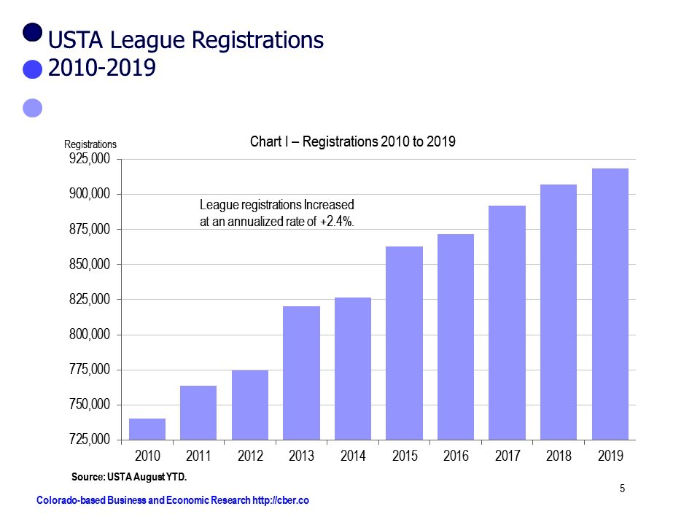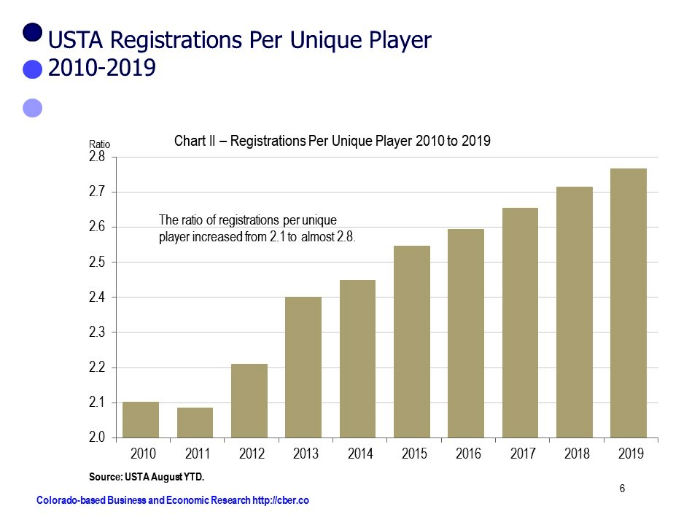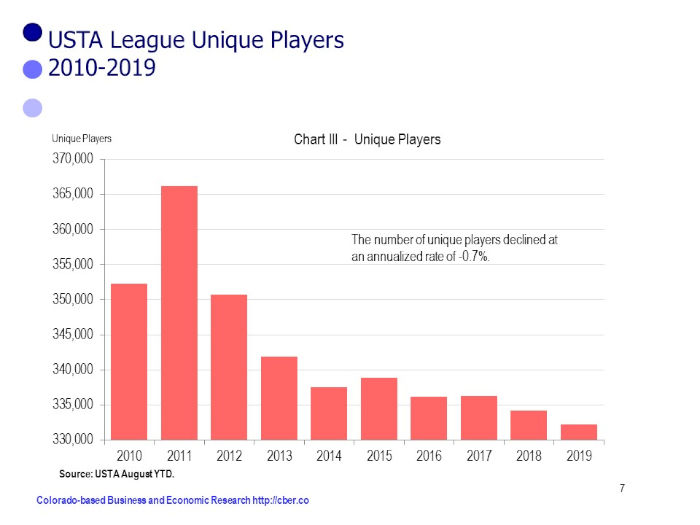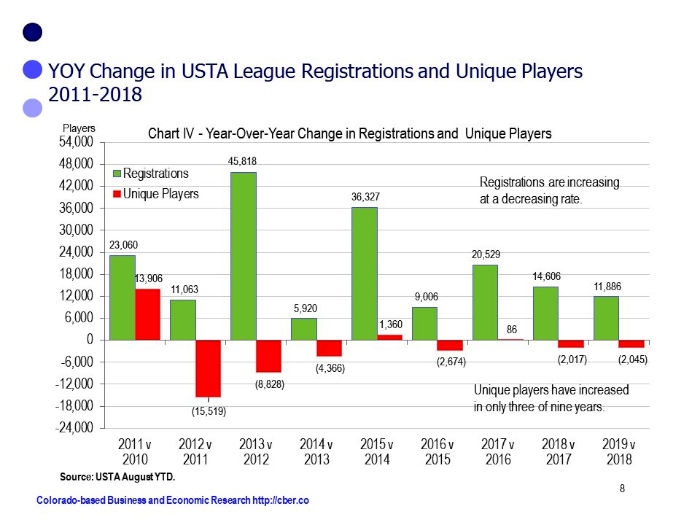|

|
Preview The terms "registrations" and "participants" are synonymous. They refer to the number of players entered in each league. It is possible for players to register for multiple leagues, which means they are counted multiple times in the participation or registration data. Registrations are important for allocating resources such as staff or courts. Obviously, the term "unique players" counts players only once, regardless of the number of leagues they participate in. The number of unique players measures the contributions of the USTA League to total tennis participation. The "registrations per unique player" is calculated by dividing the number of registrations by the number of unique players. The registrations per unique player can be used as a metric for frequency of play. Finally, "registrations" and "unique players" are not necessarily synonymous with playing time because roster sizes vary, and players may play in 20% to 100% of the matches. Background of the USTA League The pilot project was successful and in 1980 the USTA formulated a plan for a national program called the USTA League. Initially the new program was administered by the USTA and promoted it under the moniker of its outside sponsors, Michelob Lite and Volvo. In 1990, the USTA put its brand on the league and served as both sponsor and administrator. Since then the USTA League has grown as the U.S. population increased, facilities were added, and professionals and tennis organizations turned over their leagues to the USTA "for the good of the cause". In addition, the USTA ensured the growth of their program by discouraging the efforts of other tennis organizations to start their own leagues or use rating systems other than the NTRP. Registrations |

|



|
Registrations Per Unique Player At the micro level, players have a limited amount of time and money to allocate to tennis. For example, if they spend more time playing in the USTA League, they will have less time to participate in other tennis-related activities. Similarly, at the macro level, if players participate in multiple leagues at their facility, it may create an imbalance between USTA League activity, unstructured play, instructional programs, tournaments, and the many other activities that comprise a comprehensive program. |

|



|
Unique Players From an economic perspective it is puzzling that the number of unique players peaked in 2011, two years after the official end of the Great Recession. Given the demographics of tennis players and the strength and duration of the recovery, there should have been a steady increase in tennis participation between 2010 and 2019. |

|


|
Annual Change in Registrations and Unique
Players The largest change in the number of registrations occurred in 2013, the year the USTA League was restructured to "guarantee more frequency of play opportunities at more appropriate age groups." The changes temporarily stimulated growth in the number of registrations; however, they have increased at a decreasing rate since 2013. The number of unique players increased in only three of nine years. There was a significant increase in 2011 that is most likely related to the slightly larger decrease in 2012. The increases in the other two years were miniscule. |

|


|
The Impact of the USTA League on the
Tennis Industry In 2018, unique players in the USTA League represented about 2.7% of the 13.2 million adult tennis players in the U.S. Core players, those who play 10+ times a year, accounted for about 73% of the total adult players in 2018. The number of unique players in the USTA League represented at most 3.6% of the 9.7 million adult core players in 2018. The estimated size of the 2018 U.S. tennis economy was $6.2 billion. If registered participants spent $100 for league fees and tennis related goods and services while participating in the USTA League, their purchases would be about 1.6% of the total tennis economy. Average spending per unique player during the time they were registered for a league would be slightly more than $250 per unique player. The number of unique players in the USTA League represent about 45% of the total USTA membership. Moving Forward The USTA League has had a limited impact on tennis participation because it is tailored for the masses. In addition, the rules and guidelines that make it an effective national program also constrain its growth. The USTA League was re-structured and initiatives have been put in place to jump start league and overall participation. These efforts have demonstrated that repackaging current programs and establishing new initiatives are not the answer to the sport's participation woes. The tennis stakeholders who have direct contact with the players (owners, managers, tennis directors, professionals, instructors, coaches, league coordinators, and tennis retailers) must take greater responsibility for influencing people to take up the sport and play it for a lifetime. Tennis stakeholders must creatively provide the players with opportunities to have fun playing tennis in unstructured play, quality instructional sessions, and structured activities. From a league perspective, stakeholders should customize their league program to meet the needs and preferences of their players whether it is drop-in leagues, World Team Tennis or UTR leagues, in-house and non-USTA leagues, or the USTA League. Stakeholders must have a single focus on promoting and developing the sport in a way that emphasizes both attraction and retention. When that happens, overall tennis participation and the number of unique players in the USTA League will again trend in a positive direction. |

|